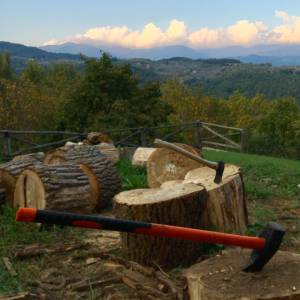The Casentino Teasle Harvest
The Teasle harvest in the Casentino is in full swing.
Across the valley the sound of the bestemiaccia (loud expressive swearing) can be heard as city folk specially drafted in collect teasle heads with blunt secateurs and dodgy gloves.
‘Porcamadosca’ and ‘fanculo a questo pezzo di merda’ echo in the blistering 33 degree sunshine that angles down onto the steep terraced slopes of this terrestrial paradise.
Since time immemorial the teasle harvest has been celebrated with drunken evenings of cold white wine and plenty of salve from ‘la pianta della Madonna’.
And for those unfortunates wearing their shorts too short there is treatment not only for the rapier-like thrashing of the spiny teasle stalks but also for the unwanted and persistent attention of the dreaded Mosca cullaia (the Tuscan arse fly).
The urban middle classes are bussed to the Casentino on the initiative of The Peasant and Sharecropper Refoundation Party led by a certain Maesta’ Renzi.
Here they recreate 15th century scenes when the humble teasle (Dipsacus fullonum) was an integral part of Tuscany’s wool textile manufactory that united imported English fleeces and Italian engineering genius.
The Teasle - then thought to be part of the carduus genus of thistles - was the origin for the notion of ‘carding’ wool - to pull the fibres of the staple in the same direction or to raise up the nap on woven wool cloth.
With these historical crumbs of orientation ringing in our ears we worked in our socially distanced ranks on the unforgiving terrazamenti for eight hours under a lacerating sun.
A number of burghers of Siena and Arezzo crashed over the high terrace walls but such was their protection by somnolent exhaustion that they suffered little injury and fell into a deep sleep under split hazel hurdles constructed by the ‘puri ma duri’ comrades of Il Partito della Rinfondazione Contadino e Mezzadria.
It was a job worth doing, an ancient cultural practice renewed, a reminder of our origins as people of the soil, of an ecological campanilismo that the Maesta Renzi intends to visit on all Italians to deepen and extend human suffering in the time of pandemics.
As the sun lowered her horns the huge bags of inert teasle heads were taken to the famous Molino dei Cardi at San Martino in Tremeletto. Here they were ground down into an acerbic flour to make the famed ‘pancaldo tremelettano’. This is an almost inedible revisiting of the ship’s biscuit made only slightly more palatable by a thick spread of gianduia spalmabile - the famous hazelnut chocolate substitute that emerged in Italy when Napoleon banned the importation of cocoa beans.
It was a mixed experience to be honest and I was glad to get back to an ice cold Guinness and a pecorino and horseradish sandwich.

Comments
Sign in or get an account to comment.


